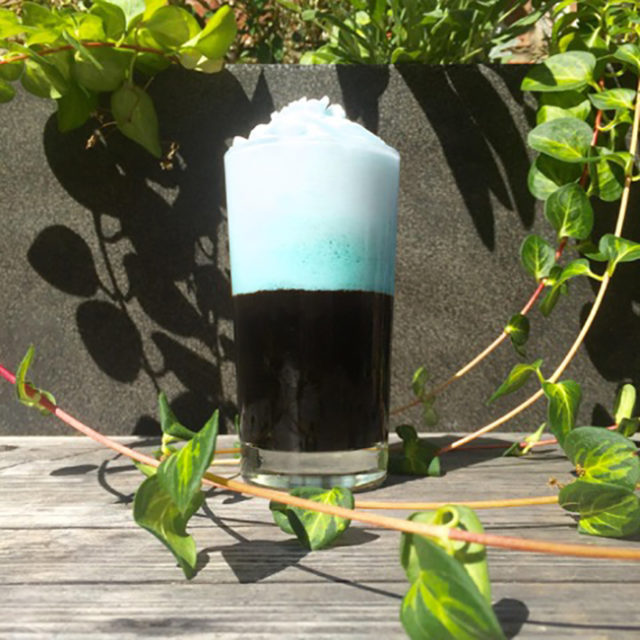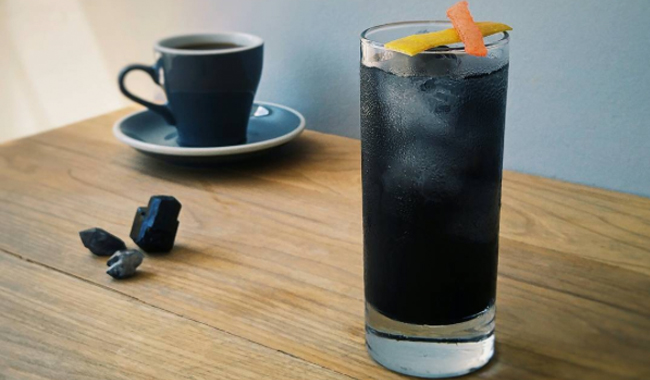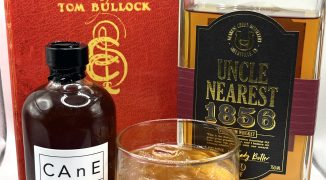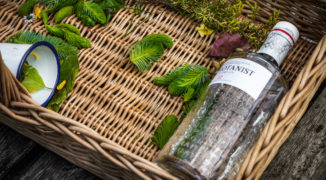Bartenders and serious drinkers alike are always on the lookout for fun, new-to-them ingredients that inspire. Lately, inky dark cocktails have been popping up more and more. Made with ingredients like activated charcoal, squid ink (important note: squid ink isn’t always okay for those with seafood allergies), toasted black sesame seeds, black walnut hulls and the like, these drinks make for dramatic, show-stopping additions to cocktail menus. They range in hue from shadowy, hazy gray to deep, dark indigo to jet black, depending on which ingredients chosen and the proportion that’s added.
Like with anything else, each ingredient option (and there are many) has different pros and cons associated with its use. Squid ink, for example, imparts a salty, briny flavor. To complement that, Kirk Gibson, bartender at Brush Izakaya in Decatur, Georgia, pairs it with mezcal.
“[I]t worked out great, like, the salt flavor was very, very faint and it complimented the tequila very well because a little bit of saline can really bring out all the other flavors,” says Gibson.
He created the drink for a Harry Potter-themed menu for a local pop-up speakeasy.
“So, when we went into the bar to prep, the three of us were deciding on how many bottles of, you know, each drink to bring, we’re kind of, doing all our prep work, and we’re like, ‘Alright, well the light shaken drink, let’s batch out 30 of those and, you know, the dark, stirred whiskey drink, let’s batch out 30 of those, blah, blah, blah.’ and we got to the mezcal and squid ink one, we all just kind of laughed and we were just kind of like, ‘Uhh, we’ve got one bottle of tequila. That’ll be plenty,’” Gibson says.
They anticipated selling no more than eight of the inky black cocktails in the night, and before they knew it — they sold out.
“So the reception was way, way better than all of us ever thought and I think that people were way more intrigued by it than turned off by it. I think they were really kind of excited about the color and the way that it came out, you know, even just how it comes out of the shaker looking like clear and black and everything.”
Toasted black sesame seeds also add flavor to the cocktails to which they’re added. Darwin Pornel, lead bartender at Faith & Flower in L.A., has experimented with both a black sesame tincture and a black sesame syrup for use in his drinks.
“I think the black sesame adds a really nice roundness, which we all kind of look for, as far as bartenders who oversee programs for restaurants go, just because it works with most dishes, you know, it’s not going to overwhelm your palate with heavy textures or sharp flavors or anything like that,” says Pornel. “So, black sesame has been something that I’ve been really trying to like hone in and kind of like make the star of this next menu as far as that kind of goes.”
The color comes from the outer husks, which get toasted and steeped in either rum or water, depending on what he’s making. The result is a deep, dark midnight shade that wows guests.
The Whistler, in Chicago, created a drink called the Black Yukon Sucker Punch (which, co-owner Billy Helmkamp noted, was a real drink on television show Twin Peaks) for one of their themed cocktail nights.
“[I]n that Black Yukon Sucker Punch, just the combination of Angostura, Black Strap, Cynar and a real, deep purple raspberry syrup, that needs absolutely nothing else added to it to make it jet-black. So that’s kind of a fun one, that’s a black cocktail that you can make without any kind of esoteric ingredient,” says Helmkamp.
 The Whistler in Chicago’s Black Yukon Sucker Punch gets its jet black hue from a combination of Angostura, Black Strap, Cynar and a real, deep purple raspberry syrup. Photo courtesy of The Whistler.
The Whistler in Chicago’s Black Yukon Sucker Punch gets its jet black hue from a combination of Angostura, Black Strap, Cynar and a real, deep purple raspberry syrup. Photo courtesy of The Whistler.
Adam Nystrom, lead bartender at E.P. & L.P. in West Hollywood, uses a charcoal made from burned coconut husks that are then pulverized into a powder, which adds a mineral component to the drink.
“It’s like licking a river rock in a mountain stream, but subtle. Its main purpose is the detoxifying effect though,” Nystrom says. Activated charcoal is also used for its documented detoxifying properties.
Nystrom’s drink is an egg white cocktail, so the visual effect, with the black base and egg white topper, is especially dramatic.
“This has definitely been one of those ‘Oh what’s that? Can I try that?’ type of drinks,” says Nystrom. “Once one goes out to a table or across the bar, a lot more are sure to follow.”
Activated charcoal, unlike some of the other ingredients that can be used to color cocktails gray or black, doesn’t add additional flavors when used in very small amounts. In fact, one of the pluses for activated charcoal is that it can be used in super small amounts, while still creating that dramatic look bartenders who use it are going for. Sometimes it’s used because it doesn’t affect the taste or texture, sometimes for its detoxifying properties and sometimes for other reasons altogether.
https://instagram.com/p/BLH7GS5jo5Y/
At Grey Tiger in Toronto, co-owner Ryan Ringer chose activated charcoal for all of those — and another specific reason.
“I used activated charcoal for a number of reasons. At Grey Tiger we serve espresso in the day, and one of the most frequent questions we’re asked by people who check our espresso menu is, ‘What’s a long black?’ Very simply put, by the way, it’s a short Americano,” Ringer says. “My Long Black aperitivo is a cheeky response to that question. When considering how to make the drink black, I discovered that activated charcoal is used industrially to decaffeinate coffee. So it seemed an appropriate option.”
There are also challenges to using it, however.
Activated charcoal is packaged as a fine powder (Helmkamp said it’s the finest product he’s ever worked with) and so can get a little messy.
Also, for all the pros of an extremely striking drink, cocktails that include ingredients like activated charcoal and squid ink can sometimes be a tough sell if guests haven’t seen the drink (which sometimes sells itself) or encountered those ingredients before.
Zachary Calfee, head mixologist and bar manager at The Roost in Greenville, South Carolina, thinks that a good way to combat any last nerves is to give it a good name. “When it gets close to Halloween, we’ll probably do a drink called the Zachary Binx, from Hocus Pocus. But that works really well for us. If the name is fun and creative and can be smart, that has helped us a little bit.”
“[W]e usually look at one or two spots on our menu as, you know, our wild card or our ‘weird drink’ in quotes and, you know, it’s always pleasantly surprising to see that that weird drink is a lot more popular than you’d ever expect,” says Helmkamp. “I do think it’s part of people naturally have a bit of adventurousness in themselves and, you know, quite frankly, when it comes to cocktails these days, we’re 10, 10+ years into the ‘cocktail revival,’ if you want to call it that, and by this point, you know, most people have tried most things and are looking for a new taste, a new flavor, some sort of new adventure with their drink and something like a black cocktail that is so visually striking, I think, scratches that itch.”
Editor’s note: Since this story’s publication, more bars are becoming aware of potential risks in using activated charcoal in drinks. For more on that, click here.
NOTICE from Tales of the Cocktail Foundation Management: While this article reflects the views of the individuals mentioned therein, it is not necessarily the view of those representing Tales of the Cocktail Foundation. Please exercise caution when working with ingredients which can be poisonous if not properly researched and handled. Improper use of these ingredients may cause serious illness or death. It’s great to try new things, but know what you’re doing before you decide to put yourself or others at risk.





